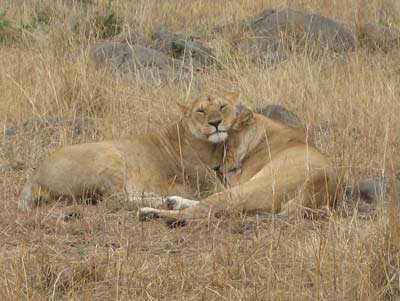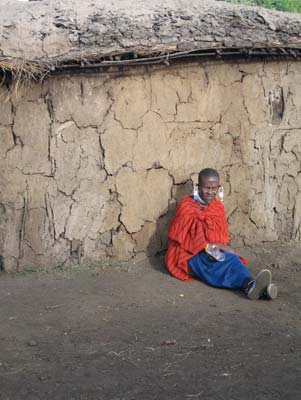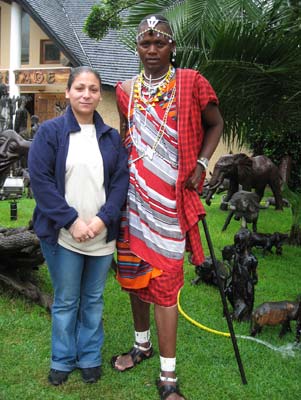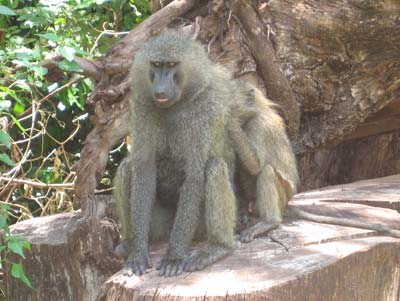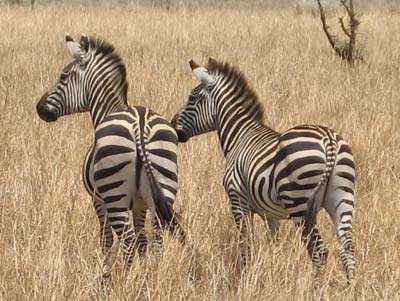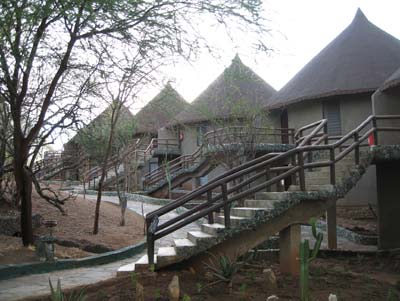Tanzania & Kenya — A mother-daughter safari
by Julie Skurdenis, Contributing Editor, photos by Katie Skurdenis-Lalli
When my daughter, Katie, was small, she had so many stuffed animals that I’d sometimes walk into her bedroom for a final ‘Good night’ and say, “Where’s my kid?” Somewhere among the cuddly pink elephants, fat-bellied hippos and lions with immense fluffy manes lay a sleeping child.
I used to think then how wonderful it would be to share a safari with her one day — not toy animals but the real thing: elephants, hippos and lions seen “on location.”
This was one dream that came true. Racking my brains for the perfect birthday gift for my now-adult daughter, it dawned on me that I could package together four or five birthdays and make a safari a reality. So it was that Katie and I spent hours combing through safari brochures, finally settling on one published by Abercrombie & Kent. After more hours poring over the many possibilities, we finally selected “Highlights of Tanzania,” a 7-night safari, and to that added a 3-night safari extension to the Masai Mara in Kenya.
Tarangire National Park
Our first night in Africa — after the long flight from New York to Arusha, Tanzania, via Amsterdam — was at the Arusha Coffee Lodge, its bungalows scattered within a working coffee plantation. There were no wild animals yet, just time to unwind, sleeping inside billowy white mosquito nets beside a wood-burning stove that took off the evening chill.
Our first safari stop was Tarangire National Park in northeastern Tanzania. We spent two nights here at the Tarangire Sopa Lodge, overlooking a landscape of plains peppered with sausage and candelabra trees — the first aptly named for its sausage-shaped hanging pods and the second for its branches resembling a huge green candelabra.
It was here that we saw our first wild animals: elephants scratching their backsides on boulders and tree trunks, zebras rolling around in the dust, and giraffes stretching to munch the thorny foliage of the tallest trees. Everyone was busy; there was no lazing around at Tarangire, apparently.
Katie’s favorite at Tarangire was the baboon families in long straggly lines loping home at sunset, with tiny infants clutching the undersides of their mothers, teenage baboons squabbling and teasing each other and patriarch baboons keeping a wary eye on us in our safari vehicle.
What I remembered most from previous safaris to Africa, besides the animals, were the spectacular lingering sunsets. This safari was no exception. Sunsets often lasted almost an hour, with pinks and oranges fading to deep purples and navy blues. Katie kept photographing until all we could see were the silhouettes of giraffes and zebras etched against an almost black sky.
Ngorongoro Crater
On the way to our second safari destination, Ngorongoro Crater, we visited Lake Manyara National Park, where a young male elephant caused a traffic jam, African-style. He stood in the middle of the road refusing to budge, and when he finally did move he ambled along at such a snail’s pace that we felt sure all we would see for the rest of our safari was his rear end.
Our teenage elephant finally meandered off the road into the bush and we were able to journey on to Ngorongoro Crater, created when an extinct volcano collapsed millions of years ago. The Sopa Lodge we stayed in here sits on the edge of the rim, with incredible views over the 2,000-foot-deep crater.
It was here, in the grass prairie at the bottom of the crater, that we saw our first big cats: a lion and lioness who slowly sauntered in front of our safari vehicle, gave us the eye and then ambled across the road and up a tree, and two lean, handsome cheetahs who strolled among an immense herd of wildebeest without causing much alarm. Clearly, the wildebeest must have sensed that the cheetahs had dined elsewhere.
Katie kept her camera at the ready in case the cheetahs changed their minds. I was relieved that they just kept on walking.
Returning up the crater rim, we visited a Masai village, a compound of dung huts with a corral in the middle for cattle. The men and boys of the village demonstrated their prowess in jumping while the women demonstrated their skill in selling us their colorful beaded bracelets and necklaces. Katie awarded them high marks for salesmanship as she watched me succumb to armfuls of bracelets and one enormous collar-necklace in rainbow colors.
Serengeti
On the way to Serengeti National Park, our third safari stop, we visited Olduvai Gorge, one of Africa’s most famous archaeological sites, where the anthropologically inclined Leakey family discovered fossils linking modern man to ape-like ancestors.
The Serengeti was the highlight of the Tanzanian portion of our safari. It’s an immense grassland — around 10,000 square miles — teeming with animals, especially those I most enjoy seeing, elephants. Katie’s favorites were the big cats. The Sopa Lodge here overlooks grasslands and a well-visited water hole.
Forgive the pun, but there were tons of elephants here, enough to make me very happy. Although I’m not sure how happy I was the afternoon an elephant family — five large matriarchs, half a dozen younger elephants and lots of pint-size ones, including some tiny babies — decided to challenge our presence.
One of the matriarchs became very upset with us and started flapping her ears and swinging her trunk in what even I recognized was a threatening gesture. The other matriarchs caught her agitation and for a few moments I thought we would be the next day’s headline in a Tanzanian newspaper. But, instead of a charge, the older elephants quickly herded the younger ones into a circle and stood facing us, defying us to come closer. We didn’t. One thing we know is when to back off, and we did, driving backward as fast as we could.
For some in our group the safari ended in the Serengeti. Not so for Katie and me. We bade farewell to Tanzania and headed north to Kenya.
Masai Mara
I loved visiting each of the wildlife areas in Tanzania; each was special and unique. But ending our trip in the Masai Mara in Kenya was the icing on our safari cake.
To begin with, there was our safari camp, Olonana. Staying in lodges is comparable to staying in comfortable hotels, albeit hotels set among grasslands and baobab trees with wild animals just outside the window. To me, however, staying in a tented camp is Africa. There are no walls between you and what you came to Africa for.
Olonana is a perfect example. This permanent tented camp has only a dozen tents situated along a meandering pathway beside the Mara River. Each is well screened from its neighbor with trees and shrubs.
Each tent is the size of a decent-size hotel room, with an attached bathroom separated from the bedroom by a curtain and featuring a large, walk-in shower. Billowy white mosquito netting encloses each of the queen-sized beds. A wooden terrace with safari chairs faces the Mara River.
Hippos love this stretch of the Mara River, and more than a dozen of them have made it their home. During our visit, at least six or seven were swimming or resting in the water close to our terrace at any one time. At lunchtime, they’d troop — very slowly, almost in slow motion — out of the river and up the bank opposite our terrace to munch on the grass and then take long snoozes.
There was also the daddy warthog who liked munching the grass next to our tent early in the morning or late at night. We saw “Mom” and her four warthog babies just outside the safari camp.
And this was outside the Masai Mara National Reserve. Inside the reserve, our wildlife cup overflowed.
We happened to luck out being in the Masai Mara during the annual migration of wildebeest and zebras from the plains of the Masai Mara back to the plains of the Serengeti in Tanzania. It was the tail end of the migration, but there were still thousands of animals on the move.
A mother’s love
Maybe I was especially attuned because I was sharing this safari with Katie, but I was aware of lots and lots of mothers and their young; protective elephant mothers, lionesses who had “parked” their cubs in a low-growing tree while they went hunting, a trio of cheetah cubs similarly parked inside a thick shrub and the warthog mom and her quartet of “warthoglets,” as Katie called them.
Two highlights among many were the prolonged nuzzling — it must have lasted 15 minutes — that ensued when two lionesses returned to their cubs waiting in a tree, and our one close sighting of rhino… very close.
There are apparently only three rhino residing in the Masai Mara and we met two of them. It was our last afternoon on safari and already well into a lingering African sunset. We were heading back to Olonana when we sighted the rhino — another mother with her baby.
Katie now lives on her own in a small apartment in New York City, but the cuddly pink elephants, fat-bellied hippos and lions with immense fluffy manes remain in her bedroom. I just never got around to cleaning them out. Now when I walk into her old bedroom I no longer look for the sleeping child among the stuffed animals. Now I walk in to recall the memories we share of the real elephants, hippos and lions.
If you go…
We traveled with Abercrombie & Kent (Oak Brook, IL; 800/554-7016, www.abercrombiekent.com), among the crème de la crème of travel companies. A&K has been in the travel business for more than 40 years, offering trips on all seven continents. I’ve traveled with them to India, China, Africa, Australia and Egypt, so it was natural to select them again for this special trip with Katie.
In Africa alone, A&K offers 21 different safari itineraries, in Kenya, Tanzania, Botswana, Zambia and South Africa. The safari we chose, “Highlights of Tanzania,” offers over a dozen departures each year.
Land prices for our safari ranged from $3,195 to $4,125 per person, depending on departure. Land arrangements for the Masai Mara extension cost $1,495 each.
Airfare — both international and internal within Africa — is extra. In our case, with flights out of New York, the cost came to $2,600 each, bringing the total cost for our safari to $16,360 for the two of us. It was not inexpensive, but how many times in life do you get to share lions, elephants and rhino with your child?
We flew KLM from New York to Arusha, Tanzania, and returned from Nairobi, Kenya. Both flights were via Amsterdam. On the overnight segment outbound to Amsterdam, we were lucky to be upgraded to business class. We slept like babies on almost fully reclining seats after dining like gourmands.
A&K booked our KLM flights for us, but you can call KLM direct (800/447-4747) if you prefer to make the arrangements yourself.
On an A&K safari, groups are generally small, guides are extremely knowledgeable and accommodating, and the available safari itineraries are amazing. And, if you don’t find something you want, you can customize your trip to suit your needs.


